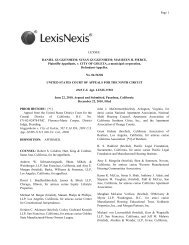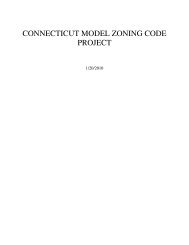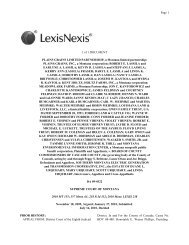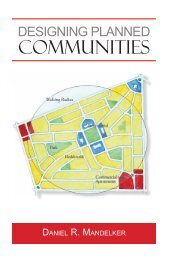Through a Glass Darkly: Measuring Loss Under ... - Land Use Law
Through a Glass Darkly: Measuring Loss Under ... - Land Use Law
Through a Glass Darkly: Measuring Loss Under ... - Land Use Law
Create successful ePaper yourself
Turn your PDF publications into a flip-book with our unique Google optimized e-Paper software.
MEASURING LOSS UNDER MEASURE 37 575<br />
use regulations axiomatically result in the devaluation of the affected<br />
property, the disparity in assessment processes results in an arbitrary<br />
and unfair application of Measure 37.<br />
While uniformity is an important safeguard for claimants, it also has<br />
a wider benefit in the form of predictability. If one valuation method is<br />
agreed-upon or mandated by the court, it will benefit all interested parties.<br />
Prospective Measure 37 claimants will be able to assess informally<br />
their chances of succeeding on the question of loss, prior to making the<br />
claim. More significantly, the state and local governments will be less<br />
cowed by the attorney fees provision; so long as they correctly apply<br />
any court-approved or uniformly agreed upon method of valuation,<br />
there should be little opportunity for claimants to argue that their claims<br />
have been improperly denied, at least with regard to the “reduction in<br />
fair market value” criterion.<br />
Establishing a comprehensive, understandable method for quantifying<br />
the devaluation in the fair market value of properties affected by the<br />
land use regulation is imperative, both to ensure uniformity of application,<br />
and also to begin formulating a strategic response to the threat<br />
Measure 37 poses to Oregon’s land use system. Public agencies must<br />
now step out of the headlights and consider how to evaluate the validity<br />
of Measure 37 compensation claims.<br />
The 2007 Oregon Legislature established a Joint Committee on <strong>Land</strong><br />
<strong>Use</strong> Fairness to resolve the many difficulties of the Measure. Among<br />
much other testimony, the Joint Committee heard a Measure 37 Report<br />
and Recommendations from former Governors Victor Atiyeh and<br />
Barbara Roberts and prominent resort developer John Gray, dated<br />
March 21, 2007. 49 That report formed one basis for a bill passed by the<br />
legislature and sent to Oregon voters to “fix” Measure 37. 50 By its terms,<br />
the “fix” was referred to Oregon voters for their approval or rejection at<br />
a special election to be held in November, 2007. 51 A companion bill<br />
extended the time in which the state or local governments were required<br />
to decide Measure 37 cases by another 360 days. 52 The effect of the<br />
extension is to allow additional time to determine the glut of claims<br />
filed shortly before the December 4, 2006, deadline for filing claims<br />
49. Measure 37 Report and Recommendations: Hearing on H.B. 3540, 74th Leg.<br />
(Or. 2007) (statement of Victor Atiyeh, former Governor and Barbara Roberts, Developer)<br />
(on file with author).<br />
50. 2007 Or. <strong>Law</strong>s ch. 424 (Enrolled House Bill 3540).<br />
51. 2007 Or. <strong>Law</strong>s ________ (Enrolled House Bill _____) (otherwise known as<br />
ballot Measure 49).<br />
52. 2007 Or. <strong>Law</strong>s ch. 133 (Enrolled House Bill 3546).<br />
ABA-TUL-07-0701-Sullivan.indd 575<br />
9/18/07 10:43:39 AM







